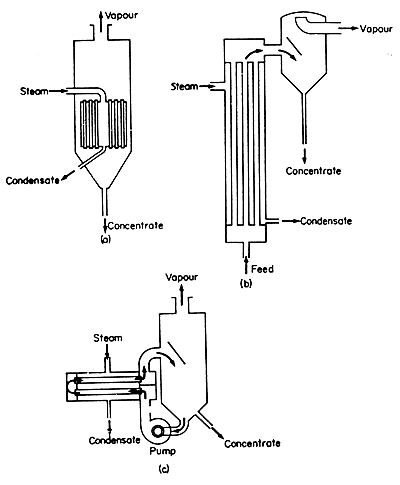Horizontal-tube Evaporators
The horizontal-tube evaporator is a development of the open pan, in which
the pan is closed in, generally in a vertical cylinder. The heating tubes
are arranged in a horizontal bundle immersed in the liquid at the bottom
of the cylinder. Liquid circulation is rather poor in this type of evaporator.
Vertical-tube Evaporators
By using vertical, rather than
horizontal tubes, the natural circulation of the heated liquid can be
made to give good heat transfer. The standard
evaporator, shown in Fig. 8.1, is an example of this type. Recirculation
of the liquid is through a large “downcomer” so that the
liquors rise through the vertical tubes about 5-8 cm diameter, boil in
the space just above the upper tube plate and recirculate through the
downcomers. The hydrostatic head reduces boiling on the lower tubes,
which are covered by the circulating liquid. The length to diameter ratio
of the tubes is of the order of 15:1. The basket evaporator shown in
Fig. 8.4(a) is a variant of the calandria evaporator in which the steam
chest is contained in a basket suspended in the lower part of the evaporator,
and recirculation occurs through the annular space round the basket.

Figure 8.4 Evaporators (a) basket type (b) long tube (c) forced circulation
Plate Evaporators
The plate heat exchanger can be adapted for use as an evaporator. The spacings
can be increased between the plates and appropriate passages provided
so that the much larger volume of the vapours, when compared with the
liquid, can be accommodated. Plate evaporators can provide good heat
transfer and also ease of cleaning.
Long tube Evaporators
Tall slender vertical tubes may be used for evaporators as shown in Fig.
8.4(b). The tubes, which may have a length to diameter ratio of the order
of 100:1, pass vertically upward inside the steam chest. The liquid may
either pass down through the tubes, called a falling- ilm evaporator,
or be carried up by the evaporating liquor in which case it is called
a climbing-film evaporator. Evaporation occurs on the walls of the tubes.
Because circulation rates are high and the surface films are thin, good
conditions are obtained for the concentration of heat sensitive liquids
due to high heat transfer rates and short heating times.
Generally,
the liquid is not recirculated, and if sufficient evaporation does not
occur in one pass, the liquid is fed to another pass. In the climbing-film
evaporator, as the liquid boils on the inside of the tube slugs of vapour
form and this vapour carries up the remaining liquid which continues to
boil. Tube diameters are of the order of 2.5 to 5 cm, contact times may
be as low as 5-10 sec. Overall heat- transfer coefficients may be up to
five times as great as from a heated surface immersed in a boiling liquid.
In the falling-film type, the tube diameters are rather greater, about
8 cm, and these are specifically suitable for viscous liquids.
Forced circulation Evaporators
The heat transfer coefficients from condensing steam are high, so that
the major resistance to heat flow in an evaporator is usually in the liquid
film. Tubes are generally made of metals with a high thermal conductivity,
though scale formation may occur on the tubes which reduce the tube conductance.
The
liquid-film coefficients can be increased by improving the circulation
of the liquid and by increasing its velocity of flow across the heating
surfaces. Pumps, or impellers, can be fitted in the liquid circuit to
help with this. Using pump circulation, the heat exchange surface can
be divorced from the boiling and separating sections of the evaporator,
as shown in Fig.8.4(c). Alternatively, impeller blades may be inserted
into flow passages such as the downcomer of a calandria- type evaporator.
Forced circulation is used particularly with viscous liquids: it may also
be worth consideration for expensive heat exchange surfaces when these
are required because of corrosion or hygiene requirements. In this case
it pays to obtain the greatest possible heat flow through each square
metre of heat exchange surface.
Also under the heading of forced-circulation evaporators are various scraped
surface and agitated film evaporators. In one type the material to be evaporated
passes down over the interior walls of a heated cylinder and it is scraped
by rotating scraper blades to maintain a thin film, high heat transfer
and a short and controlled residence time exposed to heat.
Evaporation for Heat-sensitive Liquids
Many food products with volatile flavour constituents retain more of these
if they are evaporated under conditions favouring short contact times
with the hot surfaces. This can be achieved for solutions of low viscosity
by climbing- and falling-film evaporators, either tubular or plate types.
As the viscosity increases, for example at higher concentrations, mechanical
transport across heated surfaces is used to advantage. Methods include
mechanically scraped surfaces, and the flow of the solutions over heated
spinning surfaces. Under such conditions residence times can be fractions
of a minute and when combined with a working vacuum as low as can reasonably
be maintained, volatiles retention can be maximized.
 Evaporation > SUMMARY,
PROBLEMS Evaporation > SUMMARY,
PROBLEMS
 Back
to the top Back
to the top |
![]() Open Pans
Open Pans![]() Horizontal-tube Evaporators
Horizontal-tube Evaporators ![]() Vertical-tube Evaporators
Vertical-tube Evaporators ![]() Plate Evaporators
Plate Evaporators ![]() Long-tube Evaporators
Long-tube Evaporators ![]() Forced-circulation
Evaporators
Forced-circulation
Evaporators ![]() Evaporation for Heat-sensitive Liquids
Evaporation for Heat-sensitive Liquids
